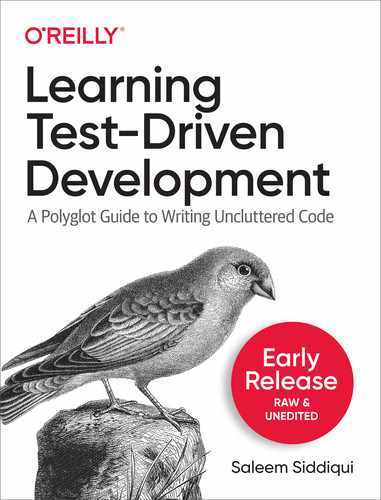Your code is a testament to your skills as a developer. No matter what language you use, your code should be clean, elegant, and uncluttered? With test-driven development (TDD), you'll write better code--code that's easy to understand, retains its elegance, and works for years to come. This indispensable guide will show you how TDD works in three different languages: Go, JavaScript, and Python. With Learning Test-Driven Development at your side, you'll be able to:
Table of Contents
- Preface
- What is Test-Driven Development
- A technique
- Designing and structuring code
- Enhanced simplicity
- Increased confidence
- Who is this book for
- What are the prerequisites for reading this book
- How to read this book
- Follow the book one language at a time
- Follow the book in two languages first and then in the third language
- Follow the book in all three languages simultaneously
- Conventions used in this book
- Typographical conventions
- Lexical conventions
- Using Code Examples
- The Apologies
- Why does this book use Go, JavaScript, and Python?
- Why not this other language?
- Why does this book have a “Chapter 0”?
- Chapter 0 - Introduction & Setup
- I. Getting Started
- 1. The Money Problem
- 2. Multi-currency Money
- 3. Portfolio
- II. Modularization
- 4. Separation of Concerns
- 5. Packages and Modules in Go
- 6. Modules in JavaScript
- Separating our code into Modules
- A segue into JavaScript Modules
- CommonJS
- Asynchronous Module Definition (AMD)
- Universal Module Definition (UMD)
- ESModules
- Improving Our Tests
- Removing redundancy in tests
- Adding a test class and test methods
- Discovering and running tests automatically
- Produce output when tests run successfully
- Run all tests even when an earlier test assertion fails
- Committing Our Changes
- Where We Are
- 7. Modules in Python
- III. Features and Redesign
- 8. Evaluating a Portfolio
- 9. Currencies, Currencies, Everywhere
- 10. Error Handling
- 11. Banking on Redesign
- IV. Finishing Up
- 12. A Living Document
- 13. Continuous Integration
- 14. Retrospective
- A. Development Environment Setup
- B. A brief history of the 3 languages
- C. Acknowledgments
